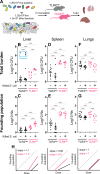This is a preprint.
Innate immune responses yield tissue-specific bottlenecks that scale with pathogen dose
- PMID: 37333208
- PMCID: PMC10274871
- DOI: 10.1101/2023.06.09.543079
Innate immune responses yield tissue-specific bottlenecks that scale with pathogen dose
Update in
-
Innate immune responses yield tissue-specific bottlenecks that scale with pathogen dose.Proc Natl Acad Sci U S A. 2023 Sep 12;120(37):e2309151120. doi: 10.1073/pnas.2309151120. Epub 2023 Sep 5. Proc Natl Acad Sci U S A. 2023. PMID: 37669395 Free PMC article.
Abstract
To cause infection, pathogens must overcome bottlenecks imposed by the host immune system. These bottlenecks restrict the inoculum and largely determine whether pathogen exposure results in disease. Infection bottlenecks therefore quantify the effectiveness of immune barriers. Here, using a model of Escherichia coli systemic infection, we identify bottlenecks that tighten or widen with higher inoculum sizes, revealing that the efficacy of innate immune responses can increase or decrease with pathogen dose. We term this concept "dose scaling". During E. coli systemic infection, dose scaling is tissue specific, dependent on the LPS receptor TLR4, and can be recapitulated by mimicking high doses with killed bacteria. Scaling is therefore due to sensing of pathogen molecules rather than interactions between the host and live bacteria. We propose that dose scaling quantitatively links innate immunity with infection bottlenecks and is a valuable framework for understanding how the inoculum size governs the outcome of pathogen exposure.
Figures


Similar articles
-
Innate immune responses yield tissue-specific bottlenecks that scale with pathogen dose.Proc Natl Acad Sci U S A. 2023 Sep 12;120(37):e2309151120. doi: 10.1073/pnas.2309151120. Epub 2023 Sep 5. Proc Natl Acad Sci U S A. 2023. PMID: 37669395 Free PMC article.
-
Species-Specific Endotoxin Stimulus Determines Toll-Like Receptor 4- and Caspase 11-Mediated Pathway Activation Characteristics.mSystems. 2021 Aug 31;6(4):e0030621. doi: 10.1128/mSystems.00306-21. Epub 2021 Aug 3. mSystems. 2021. PMID: 34342534 Free PMC article.
-
Pathogen clonal expansion underlies multiorgan dissemination and organ-specific outcomes during murine systemic infection.Elife. 2021 Oct 12;10:e70910. doi: 10.7554/eLife.70910. Elife. 2021. PMID: 34636322 Free PMC article.
-
Untangling Cellular Host-Pathogen Encounters at Infection Bottlenecks.Infect Immun. 2023 Apr 18;91(4):e0043822. doi: 10.1128/iai.00438-22. Epub 2023 Mar 20. Infect Immun. 2023. PMID: 36939328 Free PMC article. Review.
-
Unraveling enterohemorrhagic Escherichia coli infection: the promising role of dietary compounds and probiotics in bacterial elimination and host innate immunity boosting.Crit Rev Food Sci Nutr. 2023;63(11):1551-1563. doi: 10.1080/10408398.2021.1965538. Epub 2021 Aug 18. Crit Rev Food Sci Nutr. 2023. PMID: 34404306 Review.
References
-
- Rubin LG. 1987. Bacterial colonization and infection resulting from multiplication of a single organism. Rev Infect Dis 9:488–493. - PubMed
Publication types
Grants and funding
LinkOut - more resources
Full Text Sources
